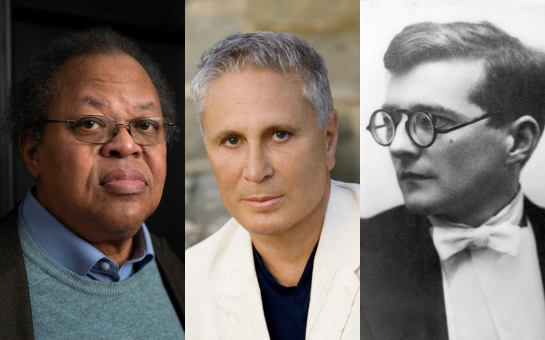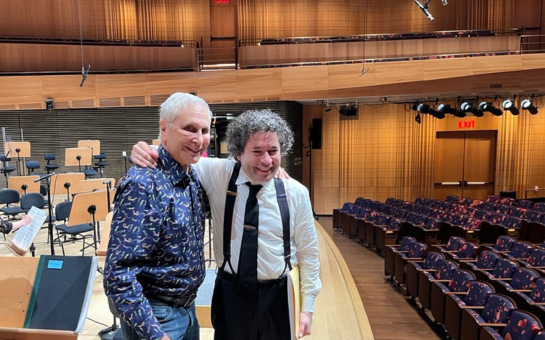In July and August 2021, Santa Fe Opera will present the world premiere of The Lord of Cries, a new opera composed by John Corigliano to a libretto by Mark Adamo. The Lord of Cries reveals intriguing intersections between two classics of Western literature — The Bacchae by Euripides and Dracula by Bram Stoker — to warn of the monster within us, not around us.
The cast features Anthony Roth Costanzo as Dionysus (the ‘Lord of Cries’), Susanna Phillips (Lucy Harker), David Portillo (Jonathan Harker), and Jarett Ott (John Seward) in lead roles. James Darrah directs the premiere production conducted by Johannes Debus.
The Lord of Cries is the second opera with music by John Corigliano, whose scores have won him the Pulitzer Prize, the Grawemeyer Award, five Grammy Awards, and an Oscar. Corigliano’s first opera is the acclaimed The Ghosts of Versailles (1991), which was The Metropolitan Opera’s first commission in almost 25 years when it first premiered to sold-out audiences. Ghosts continues to reign as one of the most significant operas of the past 50 years.
Mark Adamo first attracted national attention with the libretto and score to his uniquely successful début opera, Little Women (1998), after the novel by Louisa May Alcott. Introduced by Houston Grand Opera, Little Women has enjoyed over sixty national and international engagements. Three further full-length operas followed: Lysistrata, or The Nude Goddess (2004); The Gospel of Mary Magdalene (2013); and Becoming Santa Claus (2015) — each with a libretto by the composer.
Read
Adamo’s illuminating essay, On Ecstasy and Ruin
Watch
observations and revelations by Adamo, Corigliano, and countertenor Anthony Roth Costanzo (singing the role of Dionysus)
Listen
opera trailer, with an excerpt of Lucy and the Wolf Prince from The Lord of Cries
Tickets
Santa Fe Opera
July 17 – August 17 2021
Notes
On Ecstasy and Ruin, by Mark Adamo
Scapegoating: it is always with us. Whether it targets actual goats, as in Leviticus, or merely undocumented immigrants, as in today’s America, the pattern persists. The anti-gay bishop dragged, blinking, from his boyfriend’s bed; the attorney targeting all his city’s prostitutes save those he frequents; the puppet of foreign interests railing against the ‘rigged’ process that elected him — what have they in common? Only this: the need to blame and attack others for that which we can neither resist, nor accept, in ourselves.
The most profound dramatic exploration of this theme, and the one best suited to the opera house, remains The Bacchae of Euripides, written 1600 years ago. Its plot is simple. A violent, ecstatic, foreign god inflames the women of Thebes and threatens to recruit them permanently unless their city accepts his divinity. The city’s leader is, secretly, as curious and violent and desiring as the god is. But he cannot admit this. He denies the god, as a criminal, an alien, a fraud. The god gives the leader three chances to acknowledge his birthright. The leader refuses; once, twice, three times. After the third refusal, the god seduces the leader himself, and exacts upon him a terrible revenge.
Classics don’t age. That’s what makes them classics. But — while the theme of The Bacchae is timeless — the play’s enmeshment in arcane high-Athenian religion can mask its relevance to a contemporary audience. I wanted to tell this story in an idiom clearly intelligible to modern listeners; The Bacchae remains a modern play. But I didn’t want to locate it in so flatly contemporary a setting that the play’s uncanniness would be lost.
And then I remembered Bram Stoker’s Dracula, which is to The Bacchae what Nahum Tate’s King Lear is to Shakespeare’s: that is, the same story, with only a falsely happy ending distinguishing the compromised copy from the terrifying original. Euripides admitted what Stoker repressed: the monster isn’t on the mountain, or in the city, but in the mirror. (Which is why the novel belongs to the history of horror, whereas the play belongs to History, period.)
I concluded that mapping Dracula onto the The Bacchae could accomplish two things. By using only what the book shared with the play, I could strip away all the unnecessary Gothic kitsch of the novel. (This may be the first adaptation of the Stoker to feature not one coffin, corpse, or crucifix, nor a single drop of blood; indeed, the word vampire appears not at all in the libretto.) And because the Stoker’s Victorian England is more familiar to today’s listeners than Euripides’ Thebes is, the opera could use the novel to make the themes of The Bacchae clearer than even the original play could.
When researching another opera libretto I adapted from Greek sources, I came across the quote that ‘all classicism is neo-classicism’; meaning that, from earliest times, the past, in the theatre, has always been a mask we wear to speak more clearly about the present. I can’t summarize more succinctly the method, and the goal, of The Lord of Cries.
Background
'Consider the Source': Corigliano and Adamo in conversation with Dr. Jennifer Rhodes about the literary influences on their opera
The Santa Fe Opera and New Mexico PBS (NMPBS) will present ‘From Page To Stage,’ a series on the making of The Lord of Cries. Weekly episodes will air on NMPBS channel 5.1 at 4 p.m. MDT from July 10 through August 21, and will be streamed at newmexicopbs.org, santafeopera.org, and via the PBS Video App.
For more information, please contact your local Wise Music Promotion Team. See Contact Us.





